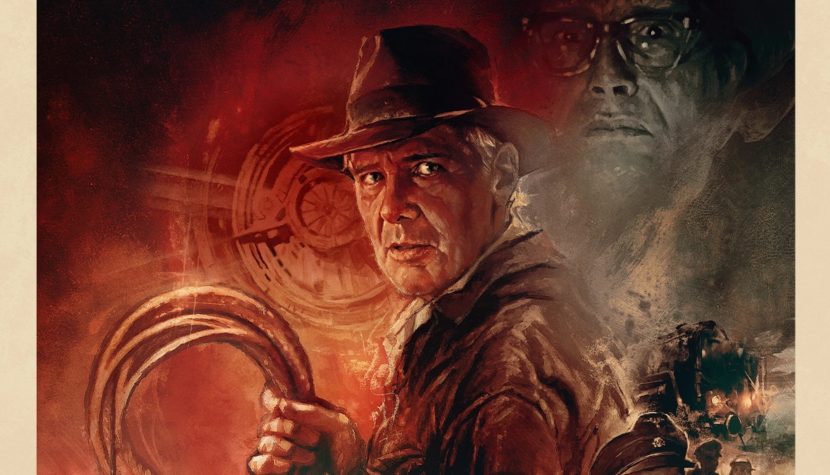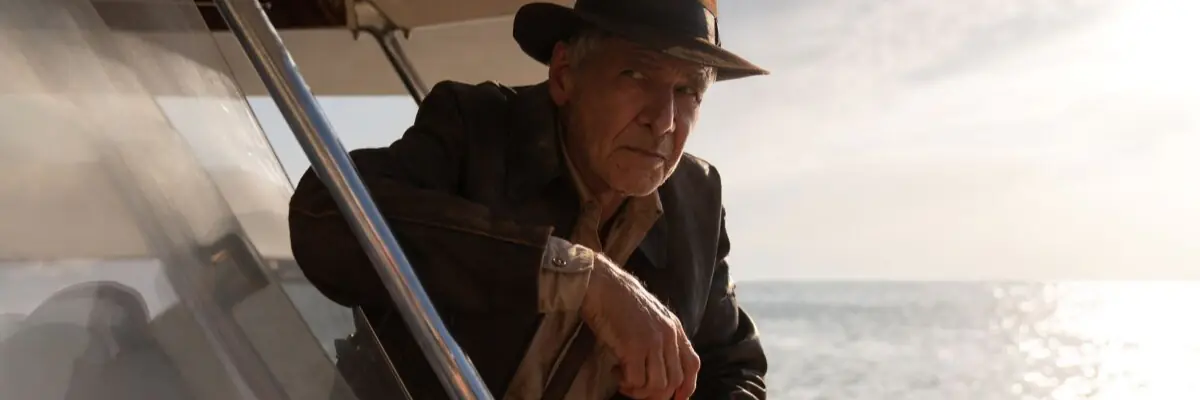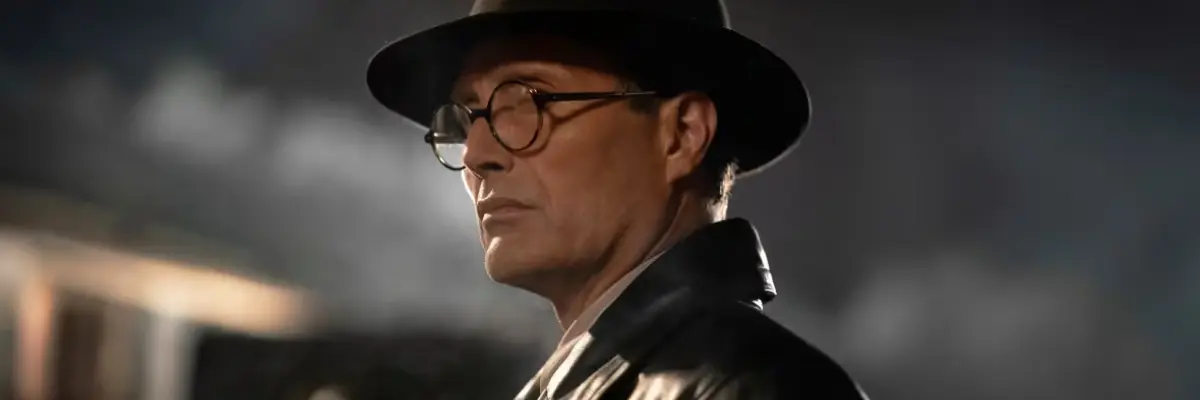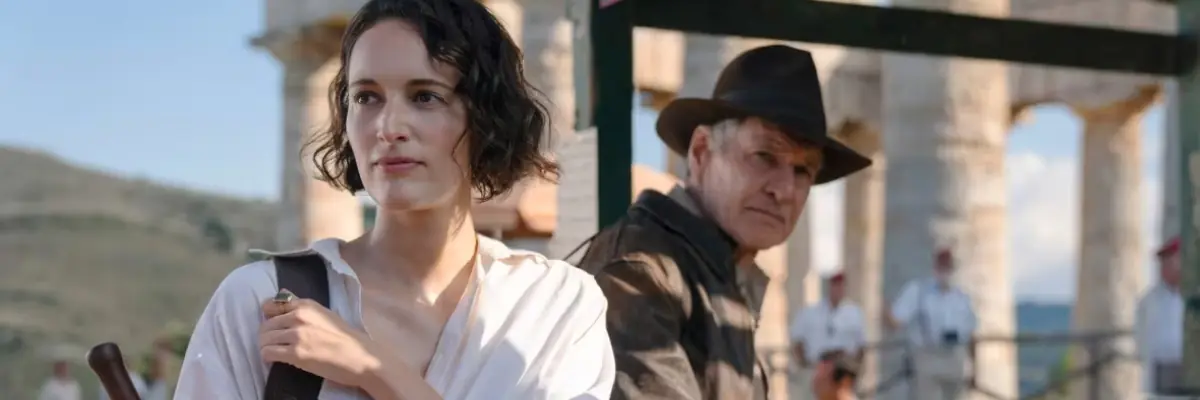INDIANA JONES AND THE DIAL OF DESTINY. Could it succeed?

After Kingdom of the Crystal Skull, it seemed there was no chance for another cinematic adventure with Dr. Jones, although from time to time there were murmurs about it here and there. Finally, in 2016, the news broke that a fifth installment of the series was in the works. Various script-related issues and later the pandemic caused multiple delays in the release date, but eventually, Indiana returned to theaters—this time with an eighty-year-old in the lead role and without Spielberg in the director’s chair. Was there ever a real chance this could succeed?
The film is structurally divided into two parts. In keeping with series tradition, we start with a prologue set in 1944 that showcases one of Indy’s wartime adventures (with a digitally de-aged Harrison Ford), and then we jump to 1969, where the main plot begins. The events of the 1940s are directly tied to the “present-day” storyline. In the opening minutes, the creators show Dr. Jones at the height of his powers, delightfully punching Nazis in the face. By the late ’60s, however, we see a man on the verge of retirement, living in the past, left behind by the world. At least until he’s visited by the daughter of an old friend, Helena (Phoebe Waller-Bridge), and Adventure once again calls upon its most loyal disciple.

Indiana Jones and the Dial of Destiny is unquestionably the “heaviest” film in the series. It’s still an escapist adventure full of fistfights and chases (although most are crammed into the first half, leaving the second half with pacing issues), but this time the screenwriters decided to give Dr. Jones a more human side. Unfortunately, they went a bit too far. The narrative starting point, particularly one element tied to the hero’s private life, feels completely misplaced, drowning the film in a bitterness that doesn’t belong in this genre. Indy’s escapades are meant to be light-hearted entertainment, and these artificial, ultimately “cheap” attempts at adding emotional depth only hurt the film. That’s my biggest criticism—it takes away a lot of the fun of following the story.
Another significant issue is the not entirely successful character arc of the protagonist (that is, the emotional journey a hero undergoes—by the end, they should be in a different psychological place than where they began). The director stated many times in interviews that the concept was simple: show Indiana in his prime in the prologue, then present a man worn down by life, who no longer expects anything from the world. Over the course of the Adventure, he’s supposed to gradually rediscover his inner swashbuckler and by the end become the Indy audiences love again. But this transformation doesn’t really happen. There’s a noticeable lack of a scene where Jones shows his “heroism.” On the contrary, in the finale, he has to be saved by someone else, as he no longer believes in himself or that he’s needed by anyone. The very last shot, just before the end credits, suggests Dr. Jones is ready for another adventure—but it’s far too little. Mangold ultimately fails to deliver on the film’s main narrative goal.

What does work very well is how Ford’s age is incorporated into the story. Though Jones is still an adventurer, it’s clear he’s lost a step. At times, he even seems fragile. He still throws punches and actively takes part in chases and fights, but it’s presented in such a way that—given the type of film this is—we can believe what we’re seeing on screen.
Each of the previous entries explored a different cultural niche. The tradition continues here, with the artifact this time connected to ancient Greece. As always, the story blends facts with a dose of fantasy. On that front, the screenwriters really floored the gas pedal. You either buy into the final act completely or not at all. Personally, I enjoyed it—it fits perfectly with the B-movie aesthetic from which the Indiana Jones series originated. You just have to let your imagination run wild. Slight disappointment comes from how the main villain Voller’s (played brilliantly as always by Mads Mikkelsen) arc is resolved. The finale could have used one more dynamic scene, as the pacing falters a bit.

Director and co-writer James Mangold moves the characters from one location to another effectively, but it’s obvious at every turn that this isn’t Spielberg. It lacks his trademark lightness and cinematic playfulness. However, John Williams does not disappoint, though the scores from previous films seem more distinctive. Overall, this final installment (at least the last one with Harrison Ford) is a solid, though flawed, adventure film—one that falls far short of the original trilogy but still offers a few emotional moments. It was also nice to see the return of Sallah (John Rhys-Davies).
The ending itself feels a bit disconnected from the rest of the film; the road leading up to it should have been better woven into the story. Still, the final shot is clever and offers a nice wink to the audience. So, farewell, Indy. It was great to see you one last time. It’s just a shame that your final on-screen adventure carries so much unnecessary bitterness, turning the obligatory happy ending into something bittersweet. That’s not quite what I hoped for in the farewell to Dr. Henry Walton Jones, Jr.

